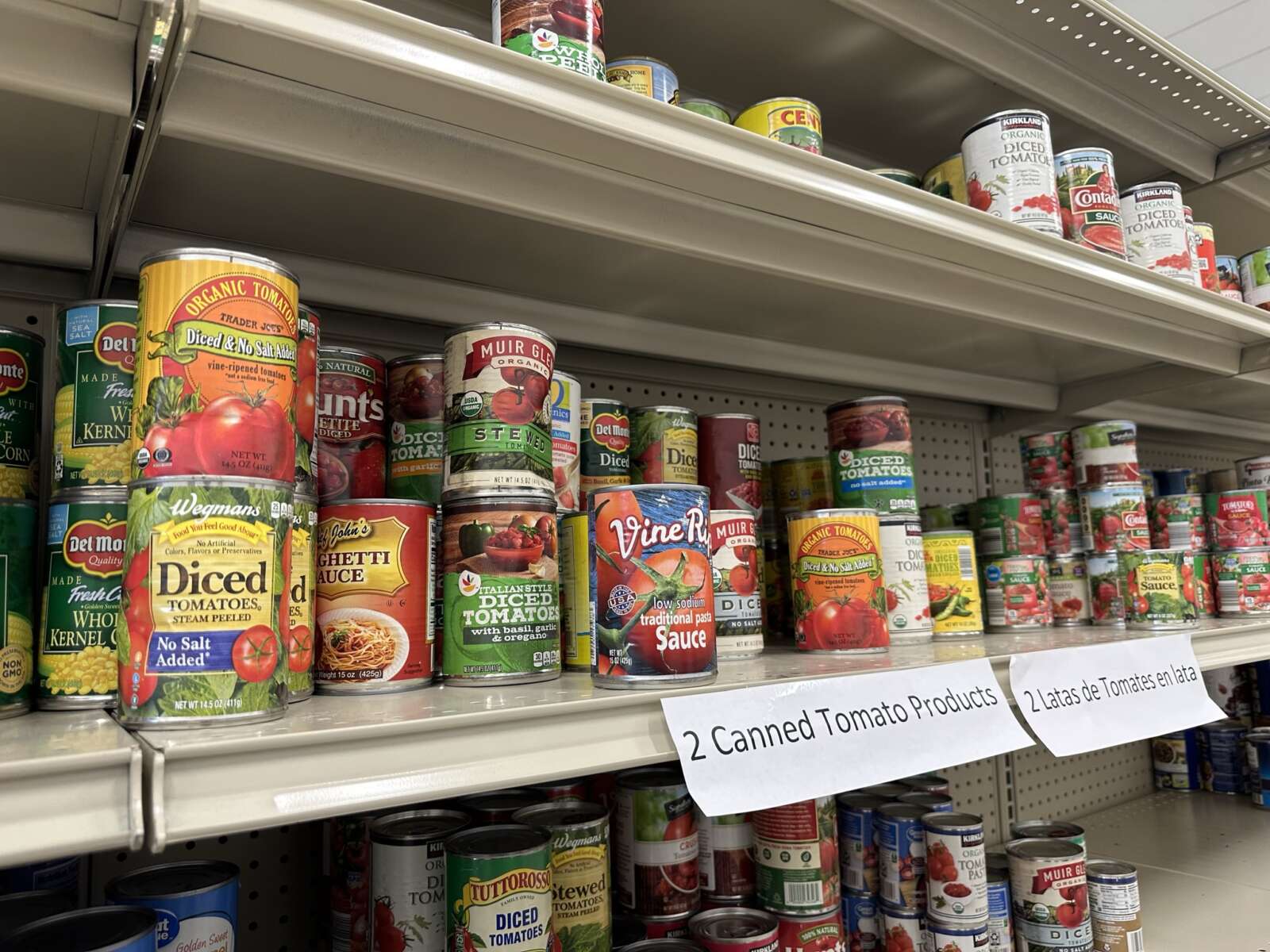
Finding sufficient, quality food remains a challenge for many people across the D.C. area, even with the immediate economic disruptions triggered by the pandemic in the rear view mirror, the Capital Area Food Bank (CAFB) says in a new report.
Released last month, the nonprofit’s 2023 Hunger Report found that the region is still seeing elevated levels of food insecurity that are nearly identical to what was reported a year earlier. In Fairfax County, 24% of residents are food insecure — the exact same percentage as in 2022.
CAFB didn’t start issuing its annual hunger reports until 2020, making a direct comparison to pre-pandemic years difficult, but the amount of food it distributes in the county has risen from 5.2 million meals in 2019 to almost 7.2 million this year, as of mid-September, indicating more need. Meal distributions peaked at more than 9 million in 2022.
“While signs of improvement seem to be everywhere in our economy over the past twelve months, there’s a far different story unfolding for over a million of our neighbors,” CAFB president and CEO Radha Muthiah said. “This year’s Hunger Report makes clear that food insecurity and economic inequity are still enormous problems in our area.”
Overall, about 32% of D.C. area residents are food insecure, including 18% who are severely food insecure, according to the 2023 Hunger Report, which is based on data collected between May 2022 and April 2023.
The only surveyed jurisdiction with less food insecurity than Fairfax County was Arlington, where 17% of households struggle to find food — a decline from 21% in 2022. Prince George’s County had the highest rate at 45%.
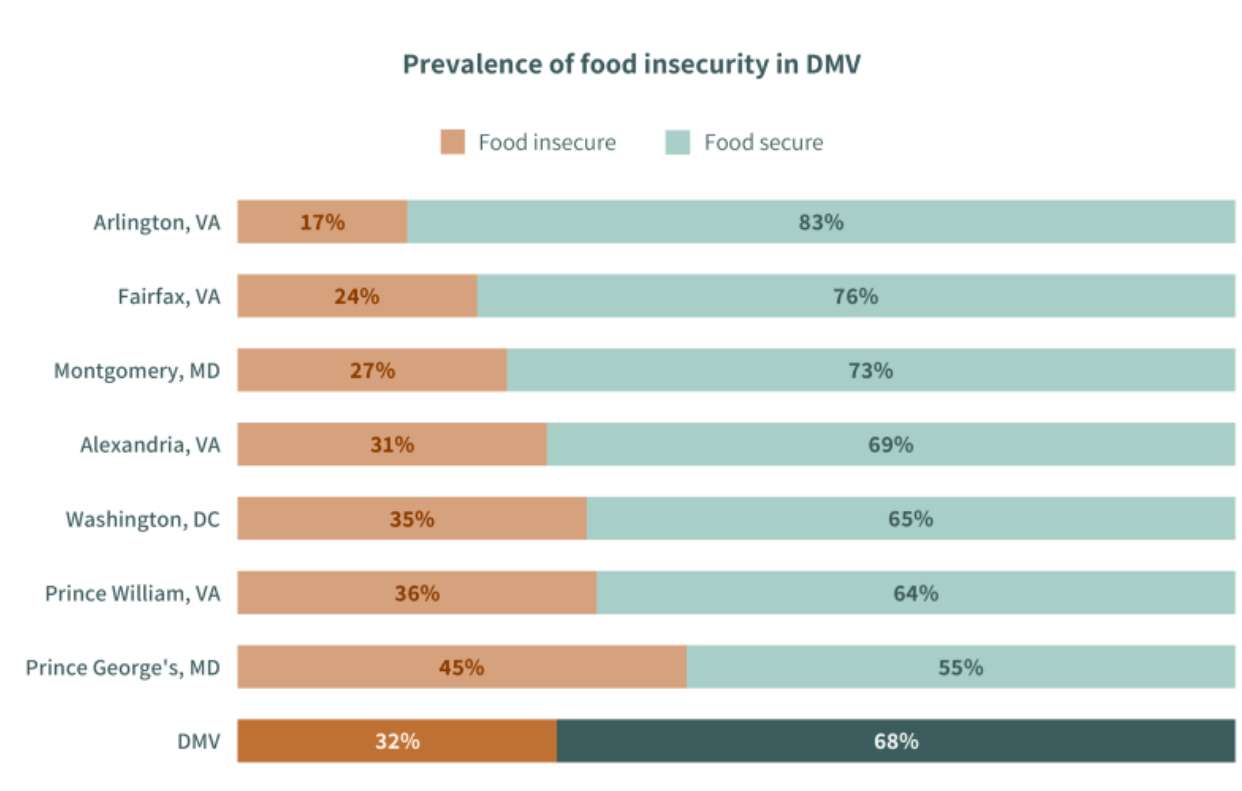
Other notable findings from CAFB:
- Food insecurity is more prevalent among Black (47%) and Hispanic (52%) respondents than white respondents (14%)
- About 82% of food-insecure households are low-income, which is defined as earning $83,000 a year or less, but 1 in 5 families who earn the area’s median income of $120,000 still experience food insecurity
- 76% of food-insecure individuals are employed — a higher rate than the one for food-secure individuals (73%)
- 10% of children are experiencing food insecurity, a lower rate than the general population that the report attributes to parents prioritizing feeding their kids over themselves and access to school meals
The lack of improvement in the region’s food insecurity levels, despite signs of a strong recovery for the U.S. economy, reflects “the pandemic’s ongoing impacts on employment, high rates of inflation, and the rollback of…government assistance programs,” such as the emergency Supplemental Nutrition Assistance Program (SNAP) benefits that ended in March, the 2023 Hunger Report says. Read More

This fall, Fairfax County will launch a guaranteed income pilot program, following in the footsteps of neighbors including Arlington County and Alexandria.
The upcoming Fairfax County Economic Mobility Pilot (FCEMP) will begin providing families with monthly payments totaling $2 million to “promote economic stability and social capital,” according to a press release.
The monthly payments of $750 will go to 180 eligible families chosen via application over the course of 15 months, with the funds being considered untaxable COVID-19 disaster relief that families have the freedom to choose how to spend.
The amount was determined by evaluating the cost of living in the county and the anticipated amount of time necessary to observe and assess the effects of guaranteed income on participants’ lives, a county spokesperson said.
Eligible families will also get access to optional financial coaching from United Way of the National Capital Area‘s Financial Empowerment Center, a partnership with Britepaths and the county, the county spokesperson continued.
“Like other basic income programs, the FCEMP promotes dignity and self-determination by enabling residents to take ownership of their own life and spending decisions,” the county website says.
Eligible applicants must be 18 years or older, have at least one child aged 16 or younger living in their household, and be employed with an income that falls between 150% and 250% of the 2023 Federal Poverty Level. They must also live in one of the following zip codes: 22306, 22309, 20190, 20191, 22041, 20170, 22003, 22150, 20120 or 20151.
The zip codes were chosen by overlaying current Opportunity Neighborhood boundaries and the zip codes they serve with the county’s Vulnerability Index, which analyzes a variety of factors such as race to determine vulnerable areas within the county, a county spokesperson said.
Through the pilot, the county says it hopes the regular payments will result in improved physical and mental health, improved educational outcomes for the children, increased economic stability, higher full-time employment rates, and increased housing and food security.
The pilot specifically aims to help certain households that “earn too much income to be eligible for assistance programs like TANF and SNAP but are struggling to make ends meet or are unable to take financial steps that would allow for economic mobility,” the county says.
As a result, households receiving public assistance benefits, such as Supplemental Security Income or Social Security Disability Income, will not be eligible. However, participants won’t lose their eligibility if they experience any changes in income or public assistance benefits during the pilot.
Supported by a partnership with Beam, a startup that helps administer cash assistance and social safety net programs, the application portal will go live on Sept. 23 and remain open until Oct. 3. Applications will be electronic only, and those selected will be notified via email or text.
The county has also partnered with George Mason University on a study of the pilot. Researchers will collect information from optional personal questions on the application “to understand the impact that unrestricted cash payments have on the economic and social well-being of working households,” the county says.
Participation in the study will not affect an applicant’s likelihood of receiving cash payments.
“Establishing a baseline understanding of families participating in the FCEMP is needed to inform a fully realized program over time,” the county says. “Thus, the FCEMP will measure the economic mobility gains and overall wellness of participants who choose to take part in the research component.”
The FCEMP is authorized by the Board of Supervisors and funded by the county’s general county and American Recovery Plan Act’s Coronavirus State and Local Fiscal Recovery Funds.
Photo via Sharon McCutcheon/Unsplash

Soon, Tysons Corner Center visitors will be able to access the internet for free, check out a library book and learn how to prepare for college or a career all from the same room.
After closing at the beginning of the COVID-19 pandemic, Fairfax County’s Community Services Room at the mall will reopen on Saturday (July 29) with an expanded array of services.
The launch will include a ribbon-cutting ceremony at 10 a.m., followed by an open house so attendees can get acquainted with the available resources. The 2,280-square-foot room is located on the mall’s second level near Nordstrom.
“Our overall commitment is to create a stronger and interconnected community where everyone has access to vital resources, support, and opportunities,” Fairfax County Neighborhood & Community Services Communications Director Cristin Bratt said. “We hope this dedicated space for programming, community resources, library services and human services support will foster a sense of belonging in the Tysons area.”
According to NCS, Tysons Corner Center has provided the space to the county for “several years” as part of its development proffers or conditions. Prior to the pandemic, the room was used by Visit Fairfax, the county’s tourism agency.
Upon taking over management of the location, NCS says it decided to partner with other county agencies and local nonprofits to offer support services that residents may have difficulty accessing otherwise, particularly with Tysons still waiting on public facilities like a community center and library.
The community services room will include two computers that anyone can use to access the internet for the purpose of applying for jobs, social services benefits, a library card and other county resources.
NCS, which provides recreational, educational and developmental programs as well as basic needs assistance, will also use the space to offer restorative services and creative outlets for teens “engaged in high-risk behavior,” according to a press release.
To further assist youth and families in need, the department has partnered with the Arlington-based nonprofit Edu-Futuro, which focuses on immigrants and other underserved individuals.
The organization will provide mentorship, education, leadership development, case management, and college and workforce development services. Its staff at the community services room will be bilingual and trained to work with Latino, immigrant and English-learning youth.
The community services room will also host Fairfax County Public Library’s outreach team for school-age and teen services and the Fairfax County Department of Family Services:
Library Services for Teens — Fairfax County Public Library’s School-Age and Teen Services Outreach team will provide library outreach to teens who face barriers in accessing library services by empowering and engaging youth and demonstrating the value and relevance of the library. Planned Library services for teens include gaming, arts and crafts, STEM, book clubs, library resource workshops and more, as well as provide access to popular library materials via a curated pop-up collection available for checkout.
Domestic & Sexual Violence Services — The Department of Family Services’ Domestic and Sexual Violence Services’ onsite services will include education; training; help planning for safety; crisis intervention; and referrals to resources for shelter, housing, counseling, and legal assistance. Services are available to individuals, families and community members impacted by domestic and sexual violence, human trafficking and stalking.
Providence District Supervisor Dalia Palchik, who represents most of Tysons, says she hopes the community services room will serve as a “hub of opportunity” where different organizations can work together.
“Empowering communities is a catalyst for positive change,” Palchik said in a statement to FFXnow. “The new Community Services Room at Tysons provides a collaborative space for individuals to connect, learn, and grow together and serves as a beacon of opportunity, fostering unity and well-being among our residents.”
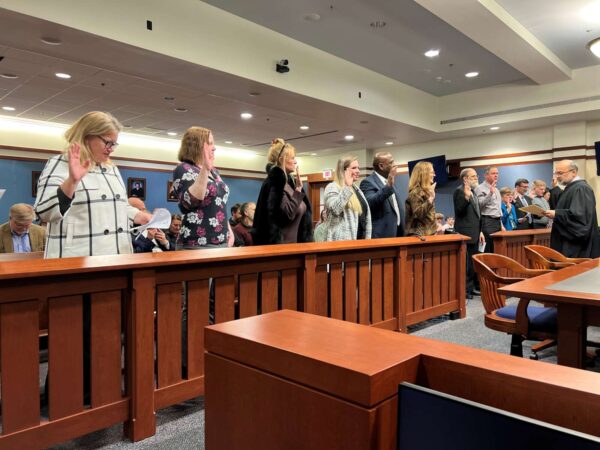
Fairfax County’s child welfare system has seen abuse and neglect cases surge over the past year, taxing the dozens of volunteers charged with advocating for those children in foster care and court.
As of May, over 188 new kids have been placed in foster care or under a protective court order since July 1, 2022 — nearly double the 98 cases added the previous year, according to Fairfax CASA, a nonprofit that trains and supervises volunteer, court-appointed special advocates for children.
With a waitlist of about 50 children, as of last week, the organization says it urgently needs more volunteers, particularly Black, Hispanic and Spanish-speaking individuals.
“It’s such an important program,” Fairfax CASA Executive Director Darcy Hubbard said. “It really does change the outcome for our most vulnerable kids, and we desperately need people right now.”
Fairfax CASA currently has about 140 volunteers assigned to cases referred by the Fairfax County Juvenile & Domestic Relations District Court. They work with attorneys and social workers to help each child get the services they need, increasing their chances of finding a safe, permanent home, according to the nonprofit.
Cases have become more complex
All of the cases are serious, since an advocate doesn’t get involved until after the court has determined a child was abused or neglected. But the issues facing families have grown in complexity this year, limiting most volunteers to one case at a time, Hubbard says.
About 60% of cases now involve domestic violence, compared to the typical rate of 30%, and cases where substance use or mental health issues are factors have also increased. For example, CASA got five cases with babies born with drugs in their bloodstream last year; this year, there have been 32 babies.
According to Hubbard, struggles with depression, anxiety and other mental illnesses have increased for both parents and kids, particularly adolescents, which tracks with Fairfax County and national reports. Alcohol consumption and fentanyl use have also gone up during the pandemic.
“In addition to the trauma and the stuff that’s going on in their families, I think whatever is going on in the world has piled on to all the kids, and for our kids, it hits them extra hard because they don’t have some of the protective factors that other children have,” such as an adult they can rely on or a sense of security at home, Hubbard said.
She emphasized that mental health and substance use issues don’t justify opening a child welfare case, but the county government and court will intervene if those challenges rise to the level of endangering the kid’s wellbeing.
“Usually, the [Department of Family Services] is well-aware of the family and has been trying to work with them and help them for a long time,” she said. Read More
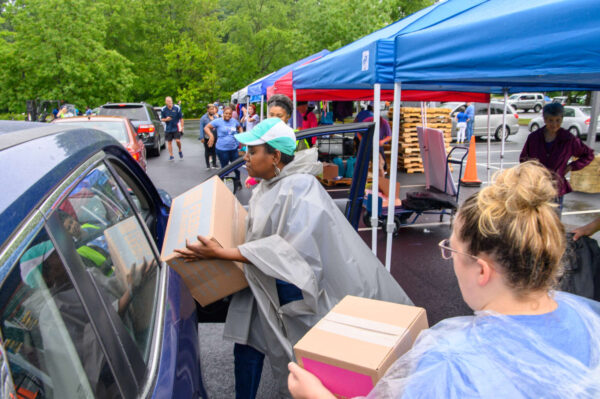
Prior to the pandemic, Fairfax County had the highest amount of food insecurity in the state. Now, some advocates say that number has more doubled.
According to the Fairfax Food Council and other county and local advocates, food insecurity remains a growing challenge for moderate-income families in what is a high cost-of-living area.
“Before the Covid [pandemic] hit this region, more than 16,000 people, including 5,000 children, turned to Cornerstones annually for help with food, affordable housing, quality childcare, job skills training, and health care access,” noted Kerrie Wilson, CEO of Cornerstones, a Reston-based nonprofit organization. “29 months later, amid the pandemic’s lingering economic and health impact, they still do.”
Cornerstones has distributed nearly 9,500 bags of fresh produce and provided support for 1,347 households in the past fiscal year through its Assistance Services and Pantry Program (ASAPP). The program also helped 38 households with roughly $20,000 in emergency utilities assistance.
Based on Cornerstones’ data, most of the households the organization served earned extremely low or very low income. Nearly 40% were led by women and 20% of the households had one individual aged 55 or above.
The rising cost of groceries, transportation and the lack of affordable housing are adding additional pressures, according to Cornerstones.
“Through this summer, our ASAPP program will continue to support families in need and work in close collaboration with local faith groups, corporate partners, and other community nonprofits to stock food pantries across the region,” Wilson said. “Our greatest need currently are donations of fresh produce and grocery store and gas gift cards.”
Overall, roughly 8% of the county is classified as severely food insecure, according to the Capital Area Food Bank’s latest hunger report, which uses a screener tool from the U.S. Department of Agriculture for food insecurity in the overall region and interviews conducted between February and March of this year.
Even though food insecurity appears to be rising, the county’s main method to connect residents to services and resources — Coordinated Services Planning — has seen a significant dip in the number of requests. After a surge in the spring of 2020, the county-based service saw a 61% decrease in emergency food requests for fiscal years 2021-2022 over fiscal years 2019 and 2020.
“Fairfax County recognizes that food insecurity is still a critical need,” Cristin Bratt, communications director for Fairfax County Neighborhood and Community Services said. “Additional supports have been put in place to support this need, which may account for the decrease in calls requesting assistance.”
The shift is in part through federal dollars granted through the federal American Rescue Plan Act’s food access program. Implemented in fiscal year 2022, the program allocated $7.5 million over three years to purchase food for community food providers and support for food system infrastructure.
So far, roughly $3.3 million has been dispersed during the first year of the program across 22 houses of worship and 26 community-based organizations. The county also offers a number of services online to those impacted by food insecurity.
But with surging inflation and an economic downturn possible on the horizon, the elephant in the room is rental and utility assistance. The county does provide help to those in need through a federally funded emergency rental assistance program, along with other federal and local resources.

A pilot program that will give monthly cash assistance to select low-income residents is in development in Fairfax County.
While eligibility criteria, payment amounts, and other details are still being determined, the county has allocated $1.5 million to the effort from its American Rescue Plan Act (ARPA) funds, as noted in a stimulus update to the Board of Supervisors’ budget policy committee yesterday (Tuesday).
First proposed at a health and human services committee meeting on June 29, the pilot will help people improve their financial situation by providing an additional, flexible source of income, county staff say.
“At its core, it’s an economic mobility initiative, but it’s also an anti-poverty initiative, and it’s certainly innovative,” Deputy County Executive Chris Leonard told the board last summer.
If it implements the pilot, Fairfax County will join a nationwide experiment with basic income programs that has also drawn in Arlington County and Alexandria. Research from around the world suggests the initiatives boost people’s happiness, health, and economic stability without limiting employment.
Fairfax County plans to model its pilot on the nonprofit UpTogether, which gives underserved individuals and families access to cash investments through an online platform that doubles as a social network.
UpTogether’s emphasis on trusting recipients to make their own decisions and building community deviates from traditional social services, which deliver vital resources like food or housing but often come with conditions, such as work requirements.
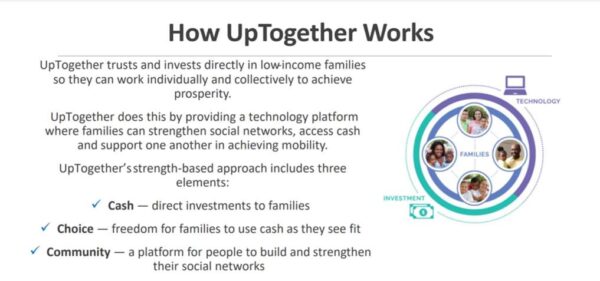
It’s the difference between helping people survive poverty and giving them the tools to escape it, Board of Supervisors Chairman Jeff McKay explained, suggesting families, particularly those with young children, as a possible target population for the pilot.
“Part of what I think our obligation to do is to stop this generational poverty that seems to happen everywhere in the country,” McKay said. “If you’re going to break the trends of generational poverty, you somehow have to get to the youth.” Read More

